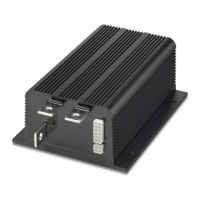Blue Ox Review of wiring diagrams [24 July 2007]
Curtis 1253 Manual, Rev. F
11
Blue Ox Rev. A, draft #1 [3 August 2007]
2 — INSTALLATION & WIRING: Throttles
WIRING: Throttles
Various throttles can be used with the 1253 controller. ey are categorized as
one of four types in the Program Menu.
Type 0: two-wire 0–5kΩ potentiometer throttles
Type 1: two-wire 5kΩ–0 potentiometer throttles
Type 2: single-ended 0–5V throttles
Type 3: single-ended three-wire 1kΩ–10kΩ pot throttles.
Table 1 summarizes the operating specifications for these four throttle types.
Table 1 WIPER INPUT: THROTTLE THRESHOLD VALUES
MINIMUM THROTTLE THROTTLE MAXIMUM
THROTTLE THROTTLE DEADBAND STARTUP MAX THROTTLE
TYPE PARAMETER FAULT (0% speed request) LOCKOUT (100% modulation) FAULT
0 Wiper Voltage — 0.6 V out of deadband 4.5 V 5.7 V
Wiper Resistance — 0 kΩ 5.0 kΩ 7.5 kΩ
1 Wiper Voltage — 4.5 V out of deadband 0.6 V 5.7 V
Wiper Resistance — 5.0 kΩ 0 kΩ 7.5 kΩ
2 Wiper Voltage — 0 V out of deadband 5.0 V 5.5 V
Wiper Resistance — — — —
3 Wiper Voltage 0.4 V 0.5 V out of deadband 5.0 V 5.5 V
Wiper Resistance — 0 kΩ 5.0 kΩ —
Notes: The upper and lower deadbands are valid for nominal 5kΩ potentiometers or 5V sources
with the default Throttle Deadband and Throttle Max parameter settings of 0% and 100%
respectively. These values will change with variations in the Throttle Deadband and Throttle
Max parameter settings—see Section 3, pages 17 and 18.
The startup lockout threshold for all throttle types is set by the Throttle Deadband.
For potentiometers, the 1253 provides complete throttle fault protection that
meets all applicable EEC regulations. For voltage throttles, the 1253 protects
against out-of-range wiper voltages (see Table 1), but does not detect wiring
faults; it is therefore the responsibility of the OEM to provide full throttle fault
protection in vehicles using voltage throttles.
Wiring for the most common throttles is described below. If the throttle
you are planning to use is not covered, contact the Curtis office nearest you.
Note: In the text, throttles are identified by their nominal range (e.g.,
5kΩ–0 pot) and not by their actual operating range.

